VVAM Newsletter 53 – 1994
Utrechtseweg 232 6862 AZ Oosterbeek The Netherlands
NEWSLETTER No. 53, February 1994
Translated by Cathrien and Peter Clark
Representative in Great Britain: Mr. E.E. Shaw, 298 Totnes Road Paignton – Devon TQ4 7HD Tel. 0803-553616
14th General Members Meeting
You are invited to attend the 14th General Members Meeting of the Society of Friends of the Airborne Museum, Oosterbeek.
The meeting, which will include the Annual Meeting, will be held in the ZALENCENTRUM LEBRET (Lebretweg 51 in Oosterbeek, tel. 085-333168) on Saturday 9 April next, commencing at 2 pm. The agenda is as follows:
1. Opening
2. Minutes of the General Members Meeting of 3 April 1993
3. General Report 1993
4. Financial Report 1993
5. Audit Committee Report
6. Budget for 1994
7. Election of Officials
8. Appointment of reserve member to the Audit Committee
9. Questions
10. Closure of the meeting Information regarding agenda point 7.
Mrs. J.M. de Langen and Mr. W.T. de Ruyter have reached the end of their term of office but both have put themselves forward for re-election. Article 8 of the statute allows for the proposal of alternative candidates.
In this event, a written nomination should reach the secretary (Utrechtseweg 232, 6862 AZ Oosterbeek) at least 10 days before the meeting, signed by a minimum of 10 members, and accompanied by a declaration of availability from the candidate. The candidate must be a Society member and an adult. Papers relating to financial matters will be sent to you separately. The Audit Commission report will be available for perusal half an hour before the meeting begins.
A film will be shown after the meeting has ended. (The management)
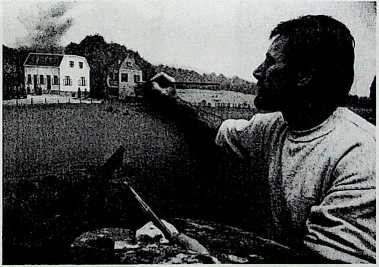
Artist Huub Milder puts the finishing touches to the rear wall of the diorama.
(photo: B. de Reus)
General Report 1993
Membership numbers have increased from 1014 to 1127, partially thanks to the new enrolment folder and despite the fact that 9 members cancelled their membership, 18 Dutch and 13 British members were expelled through non-payment of subscriptions, and 14 members died. In total the society is richer by 167 members, of which 10 are life members. The deceased are Mrs. J.M. van Kooten-van Brummelen, and the following gentlemen: Mr. A. van Maanen, Mr. G.J.J.M.
van Vaessen, Mr. F.P.K. de Jong, Mr. P.H. Jolink, Mr. J.W.H. Klein, Mr. H.
Braam, Mr. H. Bruggeman, Mr. G. Shepherd, Mr. J.P. Barnett, Mr. F. Young, Mr. J.E. Nicolson, Mr. W. Wright and Mr. E.
Coleman. Four Newsletters and Ministories appeared with, from issue 50 on, a completely new format. The excursion of 3 July and the theme afternoon of 12 December were extremely well attended. The Schools Project continued to run well in 1993. Thanks to the insurance company “Het Zilveren Kruis” (The Silver Cross), ten severely handicapped veterans could again be invited to attend the September commemoration. The society had a promotional/ sales stand at the Airborne Walk, the Pegasus Walk, the 80th anniversary of the Royal Netherlands Air Force at Eindhoven air base (2 days), the Dutch underground reunion in Nunspeet, the veterans’ reunion in Oosterbeek and the Aviation Exhibition at the Exhibition Centre in Utrecht (2 days). The total proceeds for the Airborne Museum and for the society were 3887,15 guilders and 3654 guilders respectively.
The society published two new books. In April, the Dutch and English versions of “Een Regimental Aidpost” (Cloud over Arnhem) by the late Mrs. Kate ter Horst appeared and on 12 December, the revised version of the “Roll of Honour”, by Mr. J.A. Hey, saw the light of day. The society donated a Panasonic Video Presenter to the Airborne Museum. This will also be used on our sales stands for showing video films of the Battle of Arnhem. Because of the museum renovations, the promised purchase of a display cabinet was postponed until 1994. The lottery and the sale of “square decimeters” of the rear wall of the new diorama, both in aid of the renovation, have been a success.
(J.M. de Langen)
Appeal from the treasurer
Members who have not paid their 1994 subscription are asked to do so as soon as possible.
Individual membership costs 20 guilders per year, and family membership for a year is 30 guilders.
Facelift lottery
On December the 15th 1993, the Oosterbeek solicitor Mr. Docter made the final draw in our lottery. As you know, all paid for and received lottery tickets were included in this final draw, which meant that 153 prizes found a home.
These have, in the meantime, been sent by post or delivered personally, in itself no mean task for the workgroup members. The lottery was rounded off with the presentation of the bonus prizes to those who had sold more than one book of tickets. More than sixty members managed to pull off this not inconsiderable feat. The top guns were Mrs. Rieken (220) and Mrs. Feith (137), and Mr. Purmer, with an unbelievable 433 tickets sold.
Without wishing to belittle the efforts of the other sellers, because we know what a time consuming business ticket selling can be, we would like to say an extra thank you to these “champion sellers”. A total of 7607 tickets were sold, making the gross proceeds 38,035 guilders. Total overheads (prizes, printing, postage) amounted to about 5,000, which means that we shall soon be able to hand over some 33,000 guilders to the management of the Airborne Museum Foundation.
This fine result was achieved through the communal efforts of virtually all the membership. In addition the lottery spread the name of the museum and friends far and wide, which itself resulted in a notable increase in membership. The star prize, a beautiful wall clock with a shop value of 800 guilders, was won by Mrs. Van Tongeren from Oosterbeek.
All that remains for us to do now is wind up affairs and present an account of our financial “dealings” to the Renkum council. However, we can already say: “It was a mammoth task, but it was worth all the effort and we did it with pleasure”, but nobody need ask us to organise another lottery for the coming 25 years!
(C.v.Roekel).
Presentation of the “Roll of Honour”
The new edition of the “Roll of Honour” was presented to society members during the theme afternoon held on 12 December last.
So many new facts have come to light since the first impression in 1986 that it was high time to modify the existing text. Thanks to the sterling efforts of Jan Hey, Chris van Roekel and Truus Oosterhaar, this task was brought to a satisfactory conclusion.
A future Ministory will expand on a number of the new details which have been included in this “Roll of Honour”. The book comprises 230 pages and contains, among other things, information on all the Allied servicemen who lost their lives as a result of the Battle of Arnhem. It is available at the Airborne Museum, price 20 guilders.
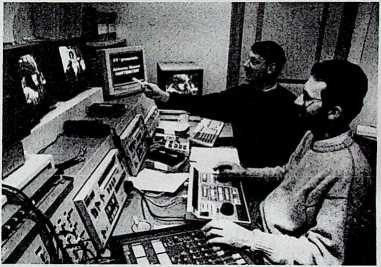
Berry de Reus and Joop Bal work on the audio-visual presentation for the refurbished Airborne Museum in the Bal Bedrijfsvideo studio.
(photo: Jenneke Bal)
53,000 guilders from the Airborne Runners
At the beginning of 1993, Mr. Harm Altena from Heelsum came up with the idea of raising money for the Airborne Museum renovation by means of a sponsored run, and the New York marathon was chosen for this purpose.
Thirty sportsmen from Oosterbeek and district decided to take part and, following nine months of intensive training, they left for America to run the marathon, which took place on the 14th of November. All thirty succeeded in completing the 26 mile, 285 yard course. In doing so they managed to raise a total of 53,000 guilders, the amount having been pledged by various sponsors.
A cheque for this amount was presented to the Airborne Museum Foundation on 17 December 1993 amid much festivity. The foundation chairman, Mr. J.W.A.M. Verlinden, thanked the Airborne’ Runners for this fantastic action through which they amassed this tremendous sum for the rebuilding and refurbishment of the Airborne Museum, in an original and sportive way.
Museum weekend and book fair
The annual museum weekend will be held on the 16th and 17th of April next. On these particular days, the Airborne Museum will focus attention on the restoration of the musealogical objects which have come into its possession in the recent past.
A book fair will be held in the museum on Saturday the 7th of May. Many old and new books about the 2nd World War will be on sale, especially books to do with the Battle of Arnhem.
Fifty years ago
Every week during this special commemorative year, the Airborne Museum will exhibit British, German and Dutch newspapers from the corresponding week(s) in 1944.
Foxholes to be protected
In various locations in the woods throughout the municipalities of Renkum and Arnhem, foxholes from the Battle of Arnhem can still be found. Although the majority have become filled with leaves and earth over the last fifty years, they are still often easy to recognise. These foxholes are of great historical importance, since they are among the few tangible items remaining from September 1944. Their positions give an insight into the strategy and progress of the struggle. Of course the foxholes consist of natural material, and are extremely vulnerable. In order to prevent their total disappearance, the Society of Friends wrote to both councils in the Autumn of 1993 requesting protection for these remaining trenches. The locations in question are at the Hemelse Berg and the Bilderberg in Oosterbeek, and at Johannahoeve (Arnhem). Renkum council have come back with a positive reaction. The foxholes will be indicated on the so- called “woods layout” so that employees whose job it is to care for and maintain the woods are aware of their positions. In this way the risk of them being filled in by accident will be avoided. However, it is certainly not the intention to re-excavate the trenches and turn them into a sort of tourist attraction. Alas, up to now there has been no response from Arnhem.
A remarkable find
A recent tip-off from an acquaintance brought the Airborne Museum into contact with a builder who was carrying out work on a house in Arnhem. A number of German documents had been found under the floorboards of the ground floor. Mr. Boersma investigated the space under the floorboards and found, amongst the thousands of glass splinters, rubble and rubbish, what appeared to be part of the administration from an SS Dental post. The find consisted principally of dental cards and X- rays relating to German servicemen.
Unfortunately the unit is not often mentioned alongside the patient’s name, but closer study has revealed that they mainly concern soldiers from the “SS Ausbildungs- und Ersatz Bataillon 12”, who were stationed in the Coehoom barracks in Arnhem. There were also a few documents from the “SS Ausbildungs- und Ersatz Bataillon 16”, units of which were stationed in Oosterbeek in September 1944. An English newspaper dating from April 1945 was also found among the rubbish, so one can conclude from this that, when the house was cleaned up after the war, this material was dumped under the floorboards. The most interesting item to be found was the card and X-rays of SS Sturmbannfiihrer Sepp Krafft, commander of the above-mentioned 16th battalion. It was this unit which caused such problems for the 3rd Parachute Battalion and the Reconnaissance Squadron during their attempts to push through to the roadbridge in Arnhem on Sunday 17 September 1944. Whether or not he was suffering from toothache at the time is difficult to determine. His card, and the other documents, are now residing in the museum’s archives. A small selection from this find is on temporary display in a cabinet in the first exhibits room.
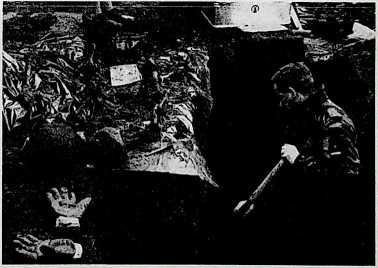
Lieutenant Jongen of the Burials unit uncovers the remains of a British soldier.
(photo: B. de Reus)
Book news
A short time ago, the book “History of the Polish Parachute Badge – Polish Airborne Forces in World War II”, written by J.J. Lorys, was published. It consists of an historical introduction followed by a list of 6,200 names of Polish and Allied servicemen who earned the right to wear the Polish para badge during World War II.
The Dutch readers can order this book by sending a Eurocheque for 10 pounds sterling to: The Polish Institute and Sikorski Museum, 20 Princes Gate, London SW7 1PT, England.
The Airborne Commemorations Foundation
In July 1992 the Airborne Commemorations Foundation became an official fact. This foundation has been set up with the aim of establishing and coordinating the official programme for the annual commemoration of the Battle of Arnhem. Besides this, the legal and financial aspects of the various commemorative activities must be coordinated and streamlined. The foundation is set up as follows. There is a general management board which consists of representatives from the various organisations which participate in the commemorations, and the activities surrounding them. The chairman of the Society of Friends of the Airborne Museum is also a member of this general management board. The municipal councils involved have each appointed an adviser who will attend the general board’s meetings.The daily management board will consist of a chairman, a vice-chairman, a secretary and a treasurer. The Queen’s provincial commissioner and the burgomasters of Arnhem, Ede, Heteren and Renkum have seats on the Steering Committee, which is primarily concerned with the broad outlines and official aspects of the programme.
The Coordinating Committee 1994 has been set up for this year’s commemoration. It is made up of the daily management board of the Airborne Commemorations Foundation, the council advisers and a representative from the Provincial Military Commander and from the (regional) Police. Professional help has been engaged to provide secretarial and organisational support for the 50th commemoration of the Battle of Arnhem. The secretariat is located in Renkum town hall: Mrs. M. van Tilburg, PO box 9100,6860 HA Oosterbeek, tel. 085-348220. It may be superfluous to mention to our members, particularly those who are Arnhem veterans, that entry tickets are required for certain events, among which the Memorial Service at the cemetery. If necessary, further information can be obtained from the above mentioned secretariat.
(Margriet van der Velden, Information Office, Renkum Municipality).
Reaction to Ministory No. 40
At the end of his extremely interesting Ministory no. 40, about the (clearance of) minefields in and around Oosterbeek, I fear that the author may have fallen victim to a misunderstanding which prevailed at that time. He writes that, after 5 May 1945, minefield clearance was carried out by German pioneer prisoners-of-war under the supervision of the Royal Engineers, and states that they “were made to walk line abreast across the field after it had been declared ‘clean’ by their commander”.
Accepting that this checking method was indeed not unusual, it should be born in mind that it was only effective in relation to anti-personnel mines…
My objection is to the use of the phrase “prisoners-of- war”. As you know, article 32 of the 1929 Geneva Convention, applicable at the time in question, emphasises that it is forbidden to use prisoners-of- war for dangerous work. The situation then was somewhat different however: by virtue of point 3 of “The Instrument of Surrender” dated 4 may 1945, which included German troops surrendering in the Netherlands, the German high command was „ obliged to carry out any further Allied orders “on any subject”, “without argument or comment”. In our country, certain items received further detailing under the rulings of the Wageningen capitulation: the German high command was given the task of nominating a German pioneer brigade for the clearing of (German) minefields in the Netherlands, which would be carried out under German control and Allied supervision. The “Pionier Brigade Draeger” from the “Festung” Hook of Holland was nominated for this task.
The personnel of this brigade thus received the unregulated status of “surrendered” as opposed to “prisoners-of-war”. In practice, the rules of the 1929 convention were applied to them insofar as this was possible. That the population of our country regarded these German servicemen as prisoners-of- war after 5 May 1945 is understandable: however, that they certainly were not!
I worked with these people from July 1945 up until July 1946 – in the provinces of Limburg, Noord Brabant and Gelderland – and I therefore consider myself qualified to correct this misunderstanding. (Mr. F.J.N. Engel, Haarlem).
Mortal remains unearthed
On Thursday the 20th and Monday the 24th of January this year, the mortal remains of two British servicemen were recovered by the Burials unit of the Royal Netherlands Army.
The remains were found in an area in northwestern Oosterbeek (previously the Sonnenberg estate in the area between the Utrechtseweg and the Valkenburglaan). Lieutenant H.J.R. Jongen and his men were called in when Flans van der Velden from Renkum came across human remains during excavation work. In line with the council’s policy of checking all future building sites and the like for ammunition and explosives, Flans swept the area with his metal detector, the ban on the transportation of such equipment having been temporarily lifted by the Burgomaster and Aidermen.
The experts from the Burials unit also found a Glider Pilot Regiment badge, a wallet, a gold signet ring with initials, an officer’s whistle, a silver cigarette case, a wristwatch, a Lee Enfield rifle complete with attached bayonet and a parachutist’s fighting knife. Only one skull, with a complete set of teeth, was found. With the aid of the British authorities and others, Lieutenant Jongen hopes that positive identification can be made before the 50th commemoration. Members of our society who think they can provide relevant information are asked to contact the editorship of this newsletter; Geert Maassen, Jan van Riebeeckweg 6861 BH Oosterbeek.

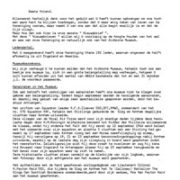
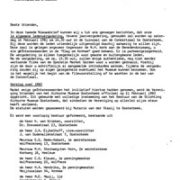
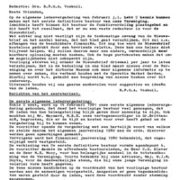
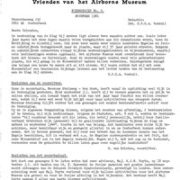
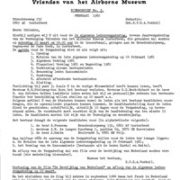
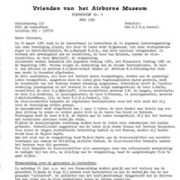
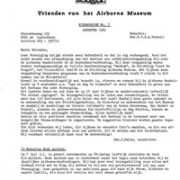
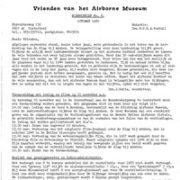
Plaats een Reactie
Vraag of reactie?Laat hier uw reactie achter.